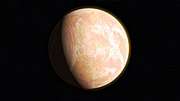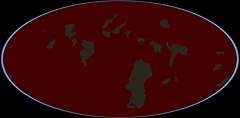Early Earth
The early Earth is loosely defined as Earth in its first one billion years, or gigayear.[1] The “ early Earth” encompasses approximately the first gigayear (Ga, 109 y) in the evolution of our planet, from its initial formation in the young Solar System at about 4.55 Ga to sometime in the Archean eon at about 3.5 Ga. [2] On the geologic time scale, this comprises all of the Hadean eon (starting with the formation of the Earth about 4.6 billion years ago[3]), as well as the Eoarchean (starting 4 billion years ago) and part of the Paleoarchean (starting 3.6 billion years ago) eras of the Archean eon.
This period of Earth's history involved the planet's formation from the solar nebula via a process known as accretion. This time period included intense meteorite bombardment as well as giant impacts, including the Moon-forming impact, which resulted in a series of magma oceans and episodes of core formation.[4] After formation of the core, delivery of meteoritic or cometary material in a "late veneer" may have delivered water and other volatile compounds to the Earth.[5] Although little crustal material from this period survives, the oldest dated specimen is a zircon mineral of 4.404 ± 0.008 Ga enclosed in a metamorphosed sandstone conglomerate in the Jack Hills of the Narryer Gneiss Terrane of Western Australia.[6] The earliest supracrustals (such as the Isua greenstone belt) date from the latter half of this period, about 3.8 gya, around the same time as peak Late Heavy Bombardment.
According to evidence from radiometric dating and other sources, Earth formed about 4.54 billion years ago.[7][8][9] Within its first billion years,[10] life appeared in its oceans and began to affect its atmosphere and surface, promoting the proliferation of aerobic as well as anaerobic organisms. Since then, the combination of Earth's distance from the Sun, its physical properties and its geological history have allowed life to emerge, develop photosynthesis, and, later, evolve further and thrive. The earliest life on Earth arose at least 3.5 billion years ago.[11][12][13] Earlier possible evidence of life includes graphite, which may have a biogenic origin, in 3.7-billion-year-old metasedimentary rocks discovered in southwestern Greenland[14] and 4.1-billion-year-old zircon grains in Western Australia.[15][16]
 Early Earth - pale orange dot
Early Earth - pale orange dot A reconstruction of what the Earth may have looked like from space in the early Orosirian, 2 billion years ago, with red oceans due to a high concentration of oxygen, causing banded iron formations
A reconstruction of what the Earth may have looked like from space in the early Orosirian, 2 billion years ago, with red oceans due to a high concentration of oxygen, causing banded iron formations
See also
- Chronology of the universe – Events since the Big Bang, 13.8 billion years ago
- Evolutionary history of life – The processes by which organisms evolved on Earth
- Future of Earth – Long term extrapolated geological and biological changes
- Geological history of Earth – The sequence of major geological events in Earth's past
- History of Earth – The development of planet Earth from its formation to the present day
- Timeline of the evolutionary history of life – Current scientific theory outlining the major events during the development of life
- Timeline of natural history
References
- Bleeker, W (2004). "Toward a 'natural' Precambrian time scale". In Felix M. Gradstein; James G. Ogg; Alan G. Smith (eds.). A Geologic Time Scale 2004. Cambridge University Press. pp. 142–143. ISBN 978-0-521-78673-7.
- Vaclav Cilek, ed. (2009). "Early Earth". Earth System: History and Natural Variability Volume I. Eolss Publishers. p. 98. ISBN 978-1-84826-104-4.
- "International Chronostratigraphic Chart 2015" (PDF). ICS. Retrieved 23 January 2016.
- Carlson, Richard W.; Garnero, Edward; Harrison, T. Mark; Li, Jie; Manga, Michael; McDonough, William F.; Mukhopadhyay, Sujoy; Romanowicz, Barbara; Rubie, David (2014-01-01). "How Did Early Earth Become Our Modern World?". Annual Review of Earth and Planetary Sciences. 42 (1): 151–178. Bibcode:2014AREPS..42..151C. doi:10.1146/annurev-earth-060313-055016.
- Drake, Michael J.; Righter, Kevin (2002-03-07). "Determining the composition of the Earth". Nature. 416 (6876): 39–44. Bibcode:2002Natur.416...39D. doi:10.1038/416039a. ISSN 0028-0836.
- Wilde, Simon A.; Valley, John W.; Peck, William H.; Graham, Colin M. (2001-01-11). "Evidence from detrital zircons for the existence of continental crust and oceans on the Earth 4.4 Gyr ago : Abstract : Nature". Nature. 409 (6817): 175–178. Bibcode:2001Natur.409..175W. doi:10.1038/35051550. ISSN 0028-0836. PMID 11196637.
- "Age of the Earth". U.S. Geological Survey. 1997. Archived from the original on 23 December 2005. Retrieved 2006-01-10.
- Dalrymple, G. Brent (2001). "The age of the Earth in the twentieth century: a problem (mostly) solved". Special Publications, Geological Society of London. 190 (1): 205–221. Bibcode:2001GSLSP.190..205D. doi:10.1144/GSL.SP.2001.190.01.14.
- Manhesa, Gérard; Allègre, Claude J.; Dupréa, Bernard & Hamelin, Bruno (1980). "Lead isotope study of basic-ultrabasic layered complexes: Speculations about the age of the earth and primitive mantle characteristics". Earth and Planetary Science Letters. 47 (3): 370–382. Bibcode:1980E&PSL..47..370M. doi:10.1016/0012-821X(80)90024-2.
- See:
- Dalrymple, G.B. (1991). The Age of the Earth. California: Stanford University Press. ISBN 978-0-8047-1569-0.
- Newman, William L. (2007-07-09). "Age of the Earth". Publications Services, USGS. Retrieved 2007-09-20.
- Dalrymple, G. Brent (2001). "The age of the Earth in the twentieth century: a problem (mostly) solved". Geological Society, London, Special Publications. 190 (1): 205–21. Bibcode:2001GSLSP.190..205D. doi:10.1144/GSL.SP.2001.190.01.14. Retrieved 2007-09-20.
- Stassen, Chris (2005-09-10). "The Age of the Earth". TalkOrigins Archive. Retrieved 2008-12-30.
- Schopf, JW, Kudryavtsev, AB, Czaja, AD, and Tripathi, AB. (2007). Evidence of Archean life: Stromatolites and microfossils. Precambrian Research 158:141–155.
- Schopf, JW (2006). Fossil evidence of Archaean life. Philos Trans R Soc Lond B Biol Sci 29;361(1470) 869-85.
- Hamilton Raven, Peter; Brooks Johnson, George (2002). Biology. McGraw-Hill Education. p. 68. ISBN 978-0-07-112261-0. Retrieved 7 July 2013.
- Ohtomo, Yoko; Kakegawa, Takeshi; Ishida, Akizumi; et al. (January 2014). "Evidence for biogenic graphite in early Archaean Isua metasedimentary rocks". Nature Geoscience. 7 (1): 25–28. Bibcode:2014NatGe...7...25O. doi:10.1038/ngeo2025. ISSN 1752-0894.
- Borenstein, Seth (19 October 2015). "Hints of life on what was thought to be desolate early Earth". Excite. Yonkers, NY: Mindspark Interactive Network. Associated Press. Retrieved 2015-10-20.
- Bell, Elizabeth A.; Boehnike, Patrick; Harrison, T. Mark; et al. (19 October 2015). "Potentially biogenic carbon preserved in a 4.1 billion-year-old zircon" (PDF). Proc. Natl. Acad. Sci. U.S.A. 112 (47): 14518–21. Bibcode:2015PNAS..11214518B. doi:10.1073/pnas.1517557112. ISSN 1091-6490. PMC 4664351. PMID 26483481. Retrieved 2015-10-20. Early edition, published online before print.
External links
- Earth – Speed through space – about 1 million miles an hour – NASA & (WP discussion)